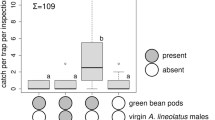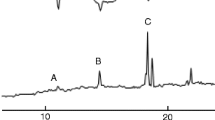Abstract
The sex pheromone of the pea midge consists of 2-acetoxytridecane, (2S,11S)-diacetoxytridecane and (2S,12S)-diacetoxytridecane. The responses of male pea midges to the corresponding stereoisomers of (2S,11S)-diacetoxytridecane and (2S,12S)-diacetoxytridecane were tested in field trapping experiments and by electroantennographic recordings. When added at 20% of the pheromone component to the sex pheromone blend, the (2S,11R)- and (2R,11S)-stereoisomers of (2S,11S)-diacetoxytridecane, were shown to have a strong inhibitory effect on male attraction in the field. At the same dose, (2R,11R)-diacetoxytridecane, (2R,12R)-diacetoxytridecane, and meso-2,12-diacetoxytridecane, did not have a significant effect on male behavior. It was also shown that substitution of either (2S,11S)-diacetoxytridecane or (2S,12S)-diacetoxytridecane with the related stereoisomers reduced trap catches to the level of blank traps. The electroantennographic recordings showed similar dose–response curves for the pheromone components and the stereoisomers shown to have an inhibitory effect. It seems likely that male antennae have receptors for both pheromone components and for inhibitory stereoisomers. Scanning electron microscopy and transmission electron microscopy of the antennae revealed three types of sensilla involved in chemoreception: sensilla circumfila, sensilla trichodea, and sensilla coeloconica. The sensilla circumfila and trichodea are both innervated by two sensory cells, whereas the sensilla coeloconica are innervated by four to five cells.
Similar content being viewed by others
REFERENCES
BAKER, T. C., FADAMIRO, H. Y., and COSSé, A. A. 1998. Fine-grained resolution of closely spaced odor strands by flying moths. Nature 393:530.
BIRCH, M. C. 1984. Aggregation in bark beetles, pp. 331-353, in W. J. Bell, and R. T. Cardé (eds.). Chemical Ecology of Insects. Chapman and Hall, London.
COSSé, A. A., TODD, J. L., and BAKER, T. C. 1998. Neurons discovered in male Helicoverpa zea antennae that correlate with pheromone-mediated attraction and interspecific antagonism. J. Comp. Physiol. 182:585-594.
CROOK, D. J., and MORDUE (LUNTZ), A. J. 1999. Olfactory responses and sensilla morphology of the blackcurrant leaf midge Dasineura tetensi. Entomol. Exp. Appl. 91:37-50.
DOANE, J. F., OLFERT, O. O., and MUKERJI, M. I. 1987. Extraction precision of sieving and brine flotation for removal of wheat midge, Sitodiplosis mosellana (Diptera: Cecidomyiidae), cocoons and larvae from soil. J. Econ. Entomol. 80:268-271.
FOSTER, S. P., HARRIS, M. O., and MILLLAR, J. G. 1991. Identification of the sex pheromone of the Hessian fly, Mayetiola destructor (Say). Naturwissenschaften 78:130-131.
GRIES, R., GRIES, G., KHASKIN, G., KING, S., OLFERT, O., KAMINSKI, L.-A., LAMB, R., and BENNETT, R. 2000. Sex pheromone of the orange wheat blossom midge, Sitodiplosis mosellana. Naturwissenschaften 87:450-454.
GUSS, P. L., SONNET, P. E., CARNEY, R. L., TUMLINSON, J. H., and WILKIN, P. J. 1985. Response of northern corn rootworm, Diabrotica barberi Smith and Lawrence, to stereoisomers of 8-methyl-2-decyl propanoate. J. Chem. Ecol. 11:21-26.
HALLBERG, E., and HANSSON, B. S. 1999. Arthropod sensilla: Morphology and phylogenetic considerations. Microsc. Res. Tech. 47:428-439.
HANSSON, B. S., VAN DER PERS, J. N. C., HöGBERG, H.-E., HEDENSTRöM E., ANDERBRANT, O., And LöFQVIST, J. 1991. Sex pheromone perception in male pine sawflies, Neodiprion sertifer (Hymenoptera: Diprionidae). J. Comp. Physiol. A. 168:533-538.
HARRIS, M. O., and FOSTER, S. P. 1991. Wind tunnel studies of sex pheromone mediated behavior of the Hessian fly (Diptera: Cecidomyiidae). J. Chem. Ecol. 17:2421-2435.
HARRIS, M. O., and FOSTER, S. P. 1999. Gall midges, pp. 27-49, in J. Hardie, and A. K. Minks (eds.). Pheromones of Non-Lepidopteran Insects Associated with Agricultural Plants. CAB International, Oxford, UK.
HILLBUR, Y., ANDERSON, P., ARN, H., BENGTSSON, M., LöFQVIST, J., BIDDLE, A. J., SMITT, O., HöGBERG, H.-E., PLASS, E., FRANKE, S., and FRANCKE, W. 1999. Identification of sex pheromone components of the pea midge, Contarinia pisi (Diptera: Cecidomyiidae). Naturwissenschaften 86:292-294.
HILLBUR, Y., EL-SAYED, A., BENGTSSON, M., LöFQVIST, J., BIDDLE, A., PLASS, E., and FRANCKE, W. 2000. Laboratory and field study on the attraction of male pea midges, Contarinia pisi, to synthetic sex pheromone components. J. Chem. Ecol. 26:1941-1952.
KRYSAN, J. L., WILKIN, P. H., TUMLINSON, J. H., SONNET, P. E., CARNEY, R. L., and GUSS, P. L. 1986. Response of Diabrotica lemniscata and D. longicornis (Coleoptera: Chrysomelidae) to stereoisomers of 8-methyl-2-decyl-propanoate and studies on the pheromone of D. longicornis. Ann. Entomol. Soc. Am. 79:742-746.
LEAL, W. S. 1996. Chemical communication in scarab beetles: Reciprocal behavioral agonist-antagonist activities of chiral pheromones. Proc. Natl. Acad. Sci. U.S.A. 93:12112-12115.
LöFSTEDT, C., HANSSON, B. S., DIJKERMAN, H. J., and HERREBOUT, W. W. 1990. Behavioural and electrophysiological activity of unsaturated analogues of the pheromone tetradecyl acetate in the small ermine moth Yponomeuta rorellus. Physiol. Entomol. 15:47-54.
LöFSTEDT, C., HERREBOUT, W. M., and MENKEN, S. B. J. 1991. Sex pheromones and their potential role in the evolution of reproductive isolation in small ermine moths (Y ponomeutidae). Chemoecology 2:20-28.
PILLON, O., and THIEULEUX, J. 1995. La cecidomyie du pois (Contarinia pisiWinn.) un noveau ravageur champenois. Med. Fac. Landbouww. Univ. Gent 60:645-650.
SEYBOLD, S. J. 1993. Role of chirality in olfactory-directed behavior: Aggregation of pine engraver beetles in the genus Ips (Coleoptera:Scolytidae). J. Chem. Ecol. 19:1809-1831.
SLIFER, E. H., and SEKHON, S. S. 1971. Circumfila and other sense organs on the antenna of the sorghum midge (Diptera, Cecidomyiidae). J. Morphol. 133:281-302.
SOLINAS, M., and NUZZACI, G. 1987. Antennal sensilla of Mycodiplosis erysiphes Ruebs. (Cecidomyiidae, Diptera). Boll. Ist. Entomol. Guido Grandi Univ. Bologna 41:173-194.
STATISTICA. 1993. Version 4.5. Statsoft Inc., Tulsa, Oklahoma.
SYSTAT. 1992. Systat Statistics, Version 5.2 edition. Systat, Inc., Evanston, Illinois.
SZöCS, G., TÓTH, M., FRANCKE, W., SCHMIDT, F., PHILIPP, P., KöNIG, W. A., MORI, K., HANSSON, B. S., and LöFSTEDT, C. 1993. Species discrimination in five species of winter-flying geometrids (Lepidotera) based on chirality of semiochemicals and flight season. J. Chem. Ecol. 19:2721-2735.
TODD, J. L., and BAKER, T. C. 1999. Function of peripheral olfactory organs, pp. 67-96, in B. S. Hansson (ed.). Insect Olfaction. Springer-Verlag, Berlin.
WALL, C., PICKETT, J. A., GARTHWAITE, D. G., and MORRIS, N. 1985. A female sex pheromone in the pea midge, Contarinia pisi. Entomol. Exp. Appl. 39:11-14.
WALL, C., BIDDLE, A. J., BLOOD SMYTH, J., FOOT, G. E., GARTHWAITE, D. G., MORRIS, N., OWEN, C. R., STURGEON, D. M., and WEYMAN, G. 1991. Local spatial and temporal distribution of pea midge, Contarinia pisi. Asp. Appl. Biol. 27:355-360.
WOJTASEK, H., HANSSON, B. S., and LEAL, W. S. 1998. Attracted or repelled? A matter of two neurons, one pheromone binding protein, and a chiral center. Biochem. Biophys. Res. Commun. 250:217-222.
ZHANG, A., ROBBINS, P. S., LEAL, W. S., LINN, C. E., VILLANI, G., and ROELOFS, W. L. 1997. Essential amino acid methyl esters: Major sex pheromone components of the cranberry white grub, Phyllophaga anxia (Coleoptera: Scarabidae). J. Chem. Ecol. 23:231-245.
Author information
Authors and Affiliations
Rights and permissions
About this article
Cite this article
Hillbur, Y., Bengtsson, M., Löfqvist, J. et al. A chiral Sex Pheromone System in the Pea Midge, Contarinia pisi. J Chem Ecol 27, 1391–1407 (2001). https://doi.org/10.1023/A:1010317310027
Issue Date:
DOI: https://doi.org/10.1023/A:1010317310027




